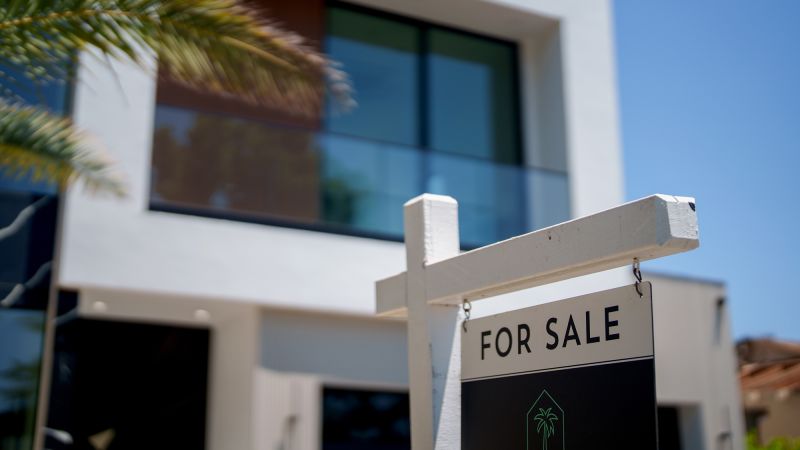The current state of the housing market in the United States, particularly in metropolitan areas like Los Angeles, reflects a significant shift from a fiery post-pandemic boom to a more temperate and cautious atmosphere. Brock and Lori Harris, a husband-and-wife real estate agent duo operating in Los Angeles, have noted this transition firsthand. Once a time when houses would be inundated with offers, often receiving about 15 bids in a single open house, now seems to be giving way to situations where properties linger on the market, attracting a far lesser interest than before.
This phenomenon of deteriorating buyer enthusiasm is not restricted to Los Angeles alone. Across the nation, the market’s once feverish state appears to be decelerating. Following the pandemic, sellers were accustomed to racing bids and limited listings that soared above their asking prices, but it appears that the climate is changing. There are now more homes up for sale than before; however, prospective buyers are exhibiting a surprising reticence. Many are sidelined due to high mortgage rates and ever-increasing insurance costs, along with stubborn property listings that feel overly inflated. The Harris couple mentioned that buyers, appearing more cautious than they have been since the onset of COVID-19, are taking their time and are more selective, reluctant to dive into potentially weak investments.
Reflecting a broader trend, real estate data shows that the current subdued buyer demand has been resulting in softened sales prices. Zillow, the well-known property search engine, revealed that over 25% of home sellers had lowered their asking prices in June – marking the highest record for this month since 2018. The National Association of Home Builders also reported that a considerable percentage of housing construction firms are now utilizing sales incentives to attract buyers, highlighting the increasing focus on drawing potential homeowners in this cooling market.
Location plays a crucial role in the housing market dynamics. A striking report by the Intercontinental Exchange stated that more than 30% of major U.S. markets had seen property prices dip by at least 1% from their recent peaks. Florida, in particular, presents a stark contrast to its previous frenzied market. Initially, the state had become a hotspot for remote workers seeking sunny retreats and looser COVID-19 regulations. However, the market in South Florida has noticeably decelerated, portraying a potential precursor of shifts happening nationwide. Sharon Ross, a real estate agent based in Delray Beach, characterized her local market as firmly in “buyer’s territory,” emphasizing the considerable inventory available.
The price descending trend witnessed in Florida appears to echo across other states like Texas, parts of California, Arizona, Colorado, and Idaho, where property values have declined over 3% from their recent highs. However, this slowdown is not uniformly shared across the United States. Certain regions, particularly in the Northeast and Midwest, are still experiencing price increases, albeit at a reduced rate compared to earlier years, indicating a mixed bag of outcomes from various markets.
Many buyers have adapted to the escalating costs associated with homeownership, with some expressing a reluctance to pay prices that seemed reasonable just a few years ago. Ross mentioned that she’s encountered numerous sellers who have pulled their listings due to unmet price expectations, illustrating the gap between seller aspirations and buyer realities.
The factors contributing to this downturn are multifaceted. Elevated home prices, along with persistent mortgage rates and economic uncertainty, all weave together an intricate narrative affecting both buyer sentiment and market performance. Daryl Fairweather, the chief economist at Redfin, articulated the hesitancy surrounding significant financial commitments amid prevailing economic fears.
The stabilization in the rental market also plays a pivotal role, as median rents have shown signs of steadiness, often making renting a more attractive prospect than purchasing. As monthly rental prices continue to rise, they might eventually prompt some renters to reconsider homeownership. Sandy McAlpine, a real estate professional in Charlotte, North Carolina, noted that many potential buyers are waiting to see if the Federal Reserve will lower interest rates, which would make borrowing more feasible.
Although mortgage rates seem to have decreased recently, predicting the Fed’s activities is a complex endeavor. Historically, when the Fed has cut rates, mortgage rates have occasionally increased in tandem. As it stands, the 30-year fixed mortgage average hovers around 6.58%, the most favorable level in ten months. Fairweather’s insights suggest that even though mortgage rates may ease in the year ahead, the volatile economic landscape could complicate matters for buyers who choose to remain on the sidelines.
Amid these shifting currents, there appears to be a unique opportunity for buyers. Present conditions may allow for better negotiation and competitive pricing, particularly in a market where the pressure once felt suffocating for those seeking a new home.












